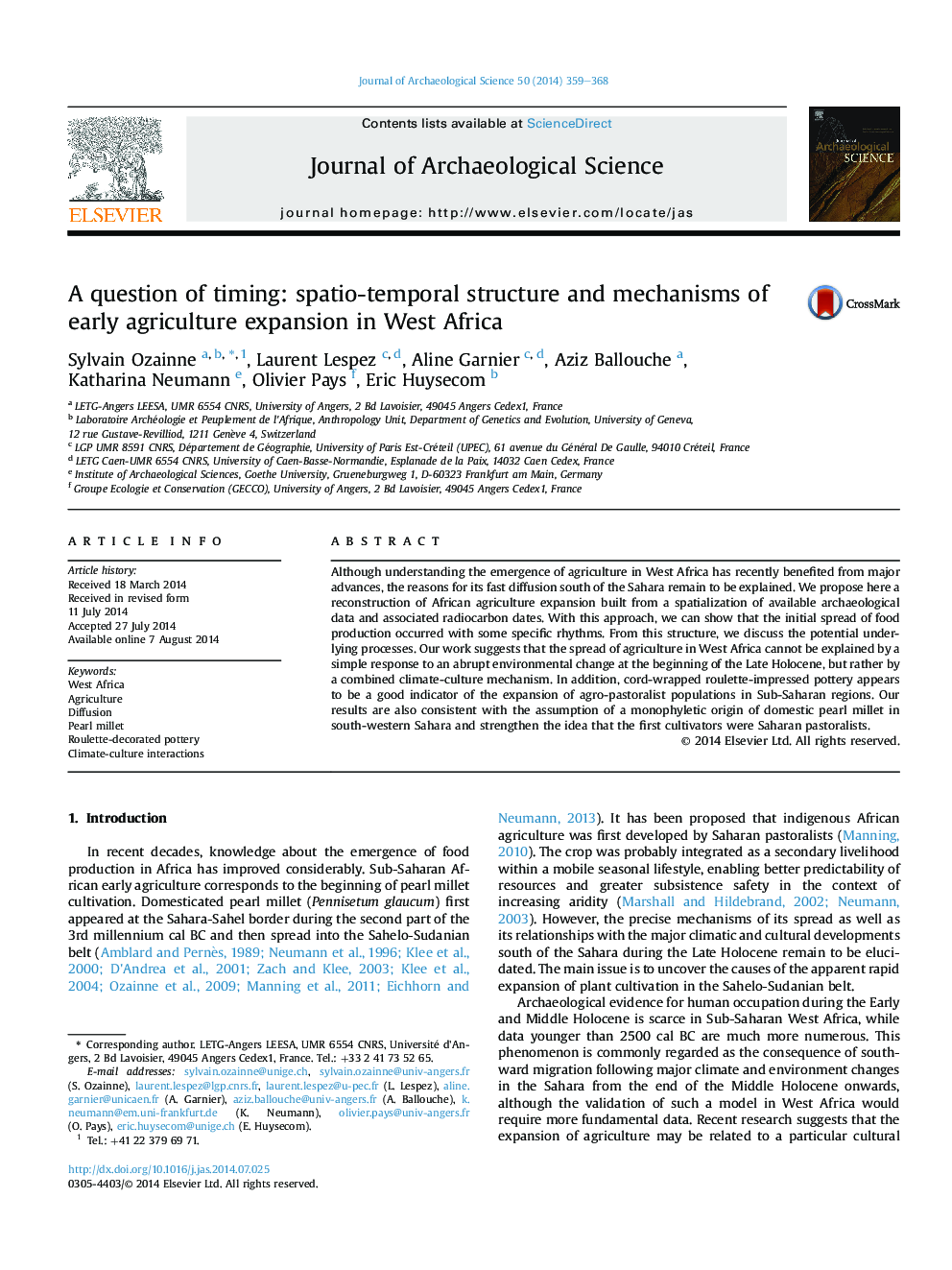| کد مقاله | کد نشریه | سال انتشار | مقاله انگلیسی | نسخه تمام متن |
|---|---|---|---|---|
| 7443000 | 1483910 | 2014 | 10 صفحه PDF | دانلود رایگان |
عنوان انگلیسی مقاله ISI
A question of timing: spatio-temporal structure and mechanisms of early agriculture expansion in West Africa
ترجمه فارسی عنوان
یک سوال از زمان بندی: ساختار فضایی و زمانی و مکانیسم گسترش زود هنگام کشاورزی در غرب آفریقا
دانلود مقاله + سفارش ترجمه
دانلود مقاله ISI انگلیسی
رایگان برای ایرانیان
کلمات کلیدی
غرب آفریقا، کشاورزی، نفوذ، ارزن مروارید، سفالگری تزئین شده با رولت، تعاملات آب و هوا،
ترجمه چکیده
اگر چه درک ظهور کشاورزی در غرب آفریقا به تازگی از پیشرفت های عمده بهره مند شده است، دلایل گسترش سریع آن در جنوب صحرای همواره توضیح داده شده است. ما در اینجا پیشنهاد بازسازی توسعه کشاورزی آفریقا را که از فضایی از داده های باستان شناسی موجود و تاریخ های مربوط به رادیو کربن ساخته شده است، پیشنهاد می کنیم. با این رویکرد، می توانیم نشان دهیم که گسترش اولیه تولید مواد غذایی با برخی ریتم های خاص رخ داده است. از این ساختار، ما در مورد فرآیندهای اساسی احتمالی بحث می کنیم. کار ما نشان می دهد که گسترش کشاورزی در غرب آفریقا را نمی توان با پاسخ ساده ای به تغییرات ناگهانی محیط زیست در ابتدای هولوسن بعد، توضیح داد، بلکه به وسیله یک مکانیزم ترکیبی از محیط زیست و فرهنگ. علاوه بر این، سفالگری تحت تاثیر رولت بند ناف به نظر می رسد شاخص خوبی برای گسترش جمعیت های کشت زراعی در مناطق جنوب صحرای آفریقا است. نتایج ما نیز با فرض یک منبع منوفیلتیک ارزن مرواریدی داخلی در جنوب غربی صحرا مطابقت دارد و این ایده را تقویت می کند که اولین کولتیواتورها گلهداران ساحره بودند.
موضوعات مرتبط
مهندسی و علوم پایه
مهندسی مواد
دانش مواد (عمومی)
چکیده انگلیسی
Although understanding the emergence of agriculture in West Africa has recently benefited from major advances, the reasons for its fast diffusion south of the Sahara remain to be explained. We propose here a reconstruction of African agriculture expansion built from a spatialization of available archaeological data and associated radiocarbon dates. With this approach, we can show that the initial spread of food production occurred with some specific rhythms. From this structure, we discuss the potential underlying processes. Our work suggests that the spread of agriculture in West Africa cannot be explained by a simple response to an abrupt environmental change at the beginning of the Late Holocene, but rather by a combined climate-culture mechanism. In addition, cord-wrapped roulette-impressed pottery appears to be a good indicator of the expansion of agro-pastoralist populations in Sub-Saharan regions. Our results are also consistent with the assumption of a monophyletic origin of domestic pearl millet in south-western Sahara and strengthen the idea that the first cultivators were Saharan pastoralists.
ناشر
Database: Elsevier - ScienceDirect (ساینس دایرکت)
Journal: Journal of Archaeological Science - Volume 50, October 2014, Pages 359-368
Journal: Journal of Archaeological Science - Volume 50, October 2014, Pages 359-368
نویسندگان
Sylvain Ozainne, Laurent Lespez, Aline Garnier, Aziz Ballouche, Katharina Neumann, Olivier Pays, Eric Huysecom,
